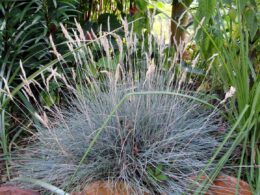Timothy Grass: Basic Information
Timothy grass (Phleum pratense) is a cool-season perennial grass. It is often used as forage for livestock, as it is high in protein and palatable to many animals. Timothy grass typically blooms in summer or spring, producing small flowers. The seeds of Timothy grass are often used in bird feed, as they are a favorite food of many bird species. Timothy grass is also known as meadow cat’s-tail or common cat’s tail.
Timothy Grass Appearance
The leaves of Timothy grass are narrow and have a prickly texture. The edges of the leaves are usually serrated, or have small teeth. The flowers of Timothy grass are small and brown, and they grow in spike-like clusters. Timothy grass can grow to be about 50-150 cm (20-59 inches) tall. The leaves can be as long as 43 cm (17 inches) and 0.5 inches wide. The leaves are hairless and rolled. The plant does not have stolons or rhizomes.
Timothy Grass Distribution and Habitat
Timothy grass (Phleum pratense) is a perennial grass that is native to temperate regions of Europe, Asia, and North America. It is a common component of meadows, pastures, and hay fields. It is one of the hardiest grains and is suitable for grazing and hay production. Timothy grass is a widely distributed perennial tufted grass native to most of Europe except the Mediterranean region. It is also naturalized in North America, New Zealand and scattered other places. It can be found in a variety of habitats with moderately rich soils, preferably near water.
Timothy Grass Uses
The main use of timothy grass is as cattle feed, although it can be used to feed other animals. It can be cut up or made into silage, haylage or baled hay depending on the climate and soil type.
Timothy Grass: Pollen
It has been used for many years as a pollen substitute for bees when there are no other pollen sources available, such as during cold seasons. The pollen is high in protein and has a similar composition to that from legumes. It makes an excellent supplement for bees when there are no other sources available, especially during the spring and fall when nectar sources are scarce.
Food for Pets
Timothy grass hay is a type of hay that is very nutritious, and therefore recommended for use as food for rodents. It is an excellent source of fiber, and it contains low protein and calcium levels. Timothy grass hay is a popular choice for rabbits, guinea pigs, chinchillas, degus and other herbivores. It can be fed as the primary food item alongside additional feeds like vegetables or dry foods. Timothy hay is known for its high fiber content and because it contains relatively low levels of protein. Timothy grass hay is also extremely easy to digest.
Growing Timothy Grass
Timothy grass seed can be planted in early spring or fall or summer and generally grows abundantly on several types of soils.
Temperature
Timothy is a winter hardy grass that tends to grow best at temperatures ranging from 40 °F to 85 °F. It has good regrowth potential after cutting and grazing if soil moisture is adequate. It will go dormant during hot summer months, but will rebound when cooler weather returns in the fall. Timothy requires about 20 inches of rainfall for good production, but has poor drought tolerance once established.
Soil
It is easily grown in fertile soils and can be used for pasture, hay and silage. Timothy does best on fertile, well-drained soils with a pH of 6.0-7.5 and tolerates wetter soils than other cool season grasses.
Light
It grows best in full sun or partial shade. Timothy does not do well in humid, hot climates, and it should not be grown with too much sun exposure.
How to Care for Timothy Grass?
In order to have a lush green lawn, you need to know the proper care and maintenance required for your grass. Timothy grass is a type of perennial grass used in lawns. It will require special care depending on the climate where it’s being grown.
Mowing
Cut timothy grass with lawnmower blades that are sharpened regularly. Avoid cutting the grass at a length shorter than this, as the plant requires some leaf area for photosynthesis and food production.
Watering
Water timothy grass deeply once or twice weekly during times of drought or hot summer weather. Allow the soil to dry out before watering. Do not water more often than this, as it will encourage shallow root growth and promote diseases such as root rot.
Fertilizing
Fertilize timothy grass monthly with a 12-12-12 fertilizer during periods of active growth, typically spring and fall in temperate climates. Follow label instructions regarding application rates, which vary depending upon the brand of fertilizer used. Apply fertilizer when the soil is dry.
Timothy Grass Vs. Alfalfa Hay
Many people are unsure of the differences between Timothy Grass and Alfalfa hay. Timothy grass is a popular hay for horses because it has a high fiber content, low protein and low calcium levels. Alfalfa hay is higher in protein and calcium. Many people think that alfalfa is more nutritious than timothy, but it actually does not have enough fiber to meet the nutritional requirements of the animal like horse.
Common Problems With Timothy Grass
Timothy grass has very few problems with pests and diseases, but there are a few things you should watch out for if you want to keep your Timothy healthy. One problem you may encounter with Timothy grass is a fungus called anthracnose (also known as leaf spot). This disease causes round spots on leaves and stems that turn brown and can eventually kill the plant. Timothy grass is an excellent choice for low-maintenance lawns because it requires very little fertilization or pruning. It does not have many special needs for growing conditions, so it can be planted in most gardens and landscapes.



















